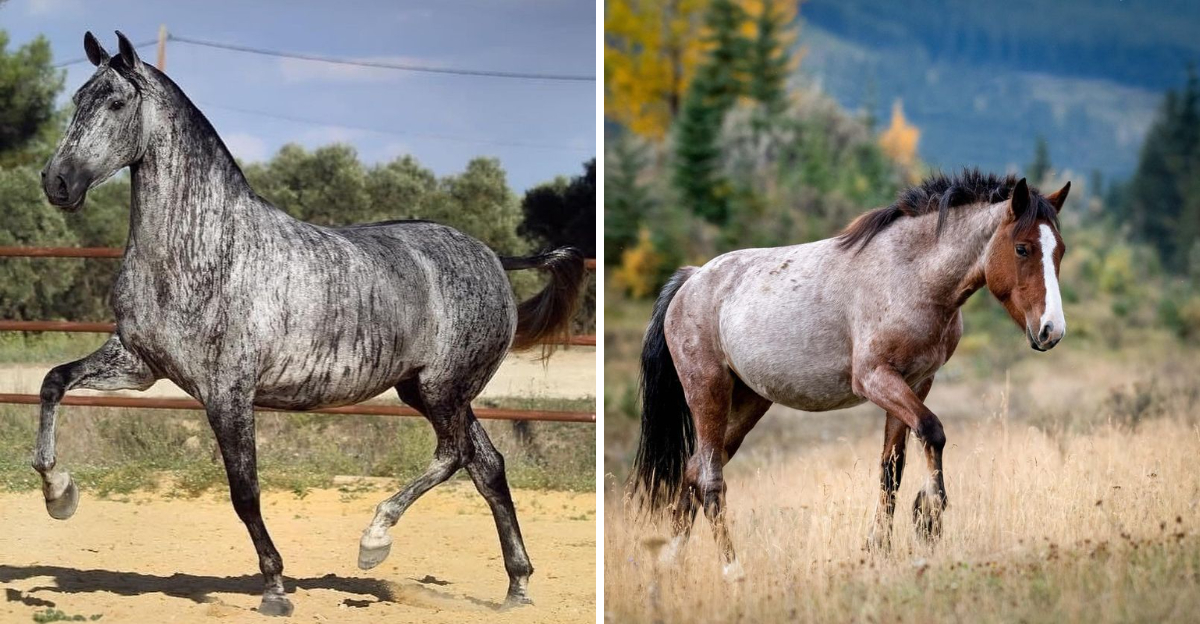Exploring the fascinating world of horse colors and patterns can reveal a lot about these majestic creatures. From the rarest, most elusive hues to the common coats that define the equestrian world, exploring these variations is far more than an academic pursuit.
It’s a way to appreciate the genetic diversity and historical significance behind each unique appearance. So, here’s a guide that will take you through the spectrum of equine beauty, showcasing 20 incredible colors and patterns that grace the horse population.
1. Brindle
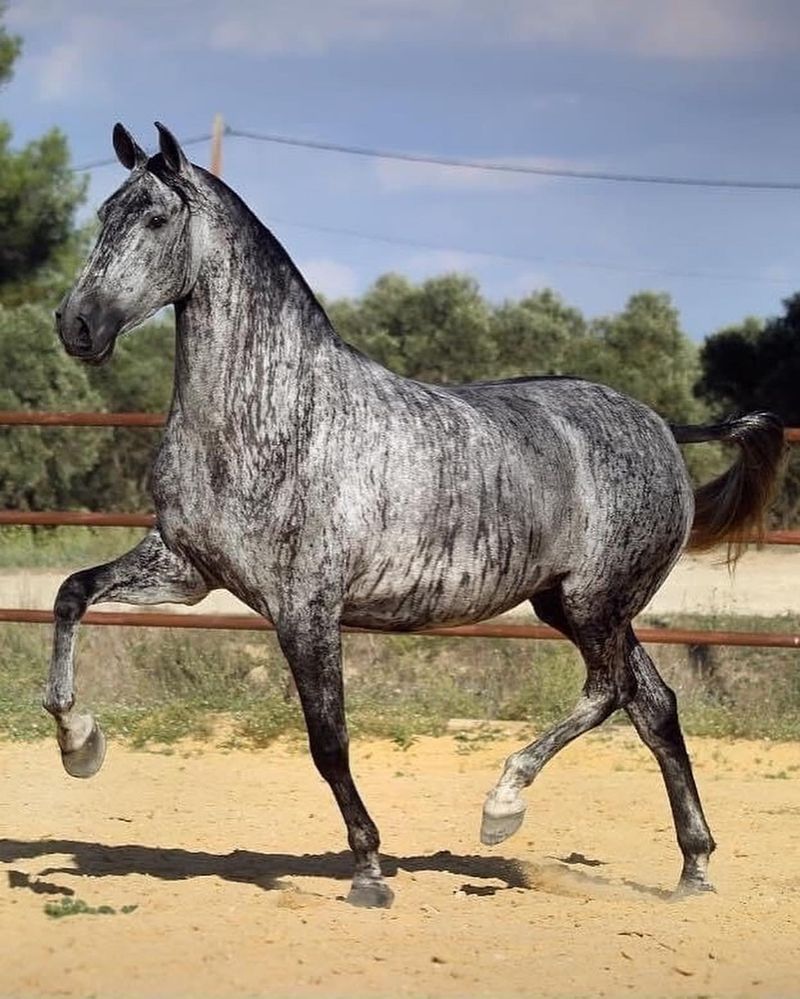
Brindle is an exceptionally rare coat pattern not often seen in the equestrian world. Its unique appearance resembles that of a tiger’s stripes, with an irregular pattern of dark and light hairs.
This captivating look is caused by specific genetic conditions that create vertical stripes on the horse’s body, often with an underlying base color of bay or chestnut. The rarity of brindle horses makes them highly sought after by breeders and horse enthusiasts alike.
Many believe that the brindle pattern adds an extra touch of elegance and mystery to the horse’s appearance. These horses can be found in various breeds, though they are uncommon regardless of the breed.
Intriguingly, the genetics behind the brindle pattern remain a topic of ongoing research, with scientists exploring how these unique markings develop. For those lucky enough to encounter a brindle horse, it is truly a sight to behold.
2. Perlino
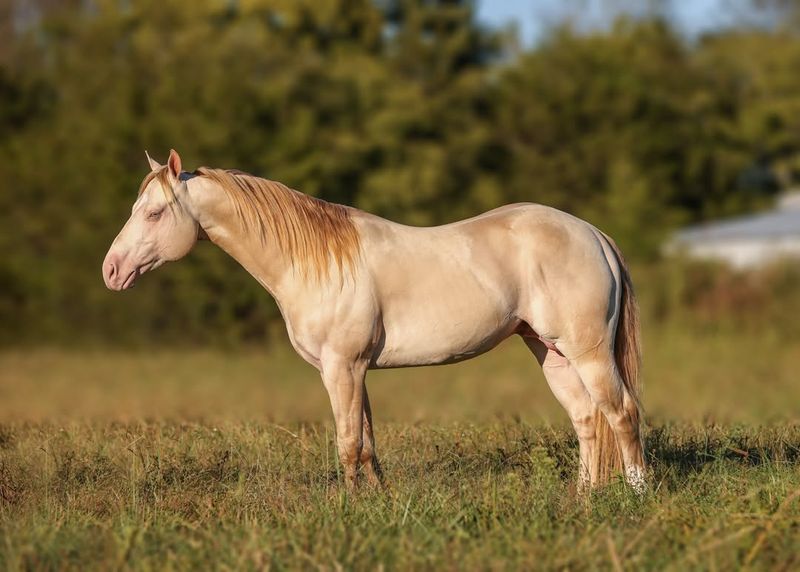
Perlino horses are renowned for their striking cream-colored coats and captivating pale blue eyes. This rare color is a result of the cream gene acting on a bay base coat, diluting the color to produce the cream hue.
Additionally, a perlino horse often exhibits a pinkish skin tone, especially around the muzzle and eyes, adding to its distinctive appearance. These horses are not only beautiful but also have a notable shine that can be quite eye-catching in the sunlight.
The perlino’s unique attributes make it a favorite among horse lovers who appreciate something out of the ordinary. This color is often seen in Akhal-Teke, one of the most expensive horse breeds, known for their metallic sheen, and the American Cream Draft.
3. Silver Dapple
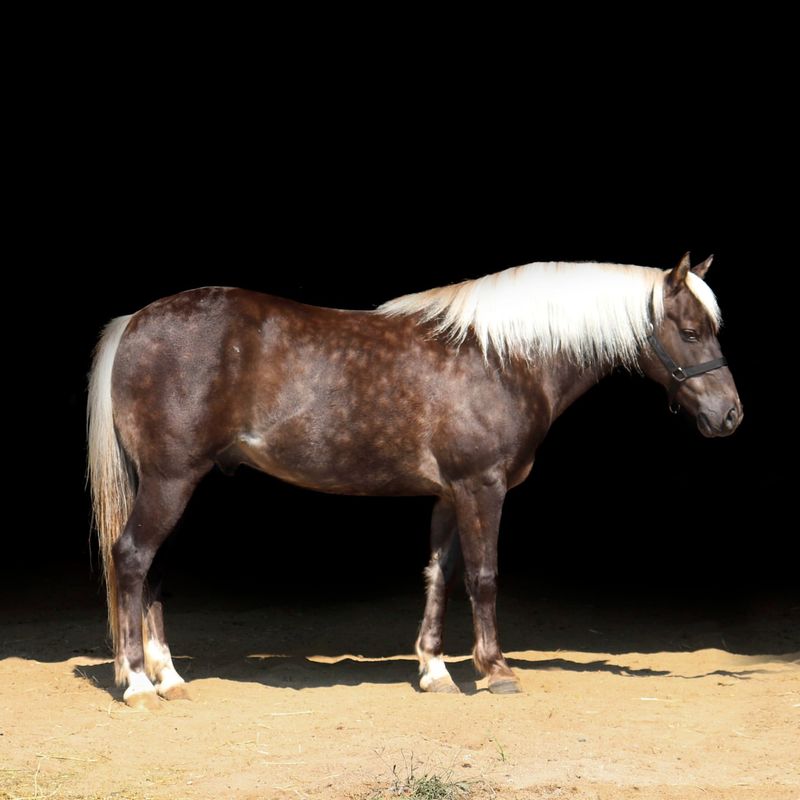
Silver Dapple is a mesmerizing color pattern characterized by a chocolate-colored coat paired with a silver or white mane and tail. This unique combination results from the silver gene affecting a black base coat, creating a striking contrast that is both elegant and eye-catching.
The silver dapple pattern can vary significantly between individual horses, with some showing a more pronounced dapple effect than others. It’s a captivating look that often draws attention in the show ring and among horse enthusiasts.
Though not extremely common, silver dapple horses can be found in certain breeds like the Rocky Mountain Horse and the Icelandic horse. Their distinct appearance and graceful presence make them a favored choice for those seeking a horse with a unique and enchanting look.
4. Cremello
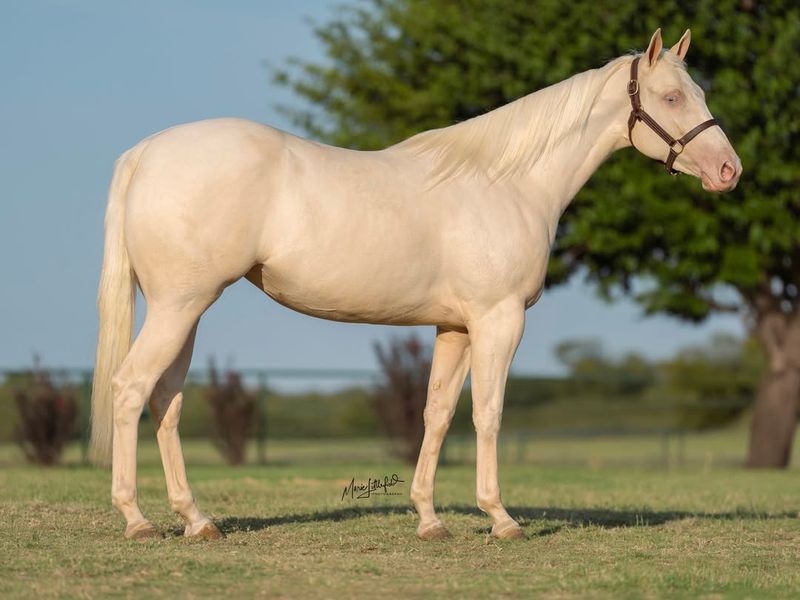
Cremello horses are known for their ethereal appearance, with coats that seem to glow with a pale cream color. This unique look is achieved through the presence of two cream genes acting on a chestnut base coat, leading to the dilution of the color to an almost white shade.
One of the most striking features of a cremello horse is its piercing blue eyes, which stand out against the creamy coat. The light skin, usually pink, especially around the muzzle, adds to the horse’s distinctive appearance.
Cremello horses are often sought after for their striking looks and are found in breeds like the Quarter Horse and the American Saddlebred. Their elegant and almost mystical appearance makes them a favorite among those who appreciate a horse that stands out in a crowd.
5. Champagne
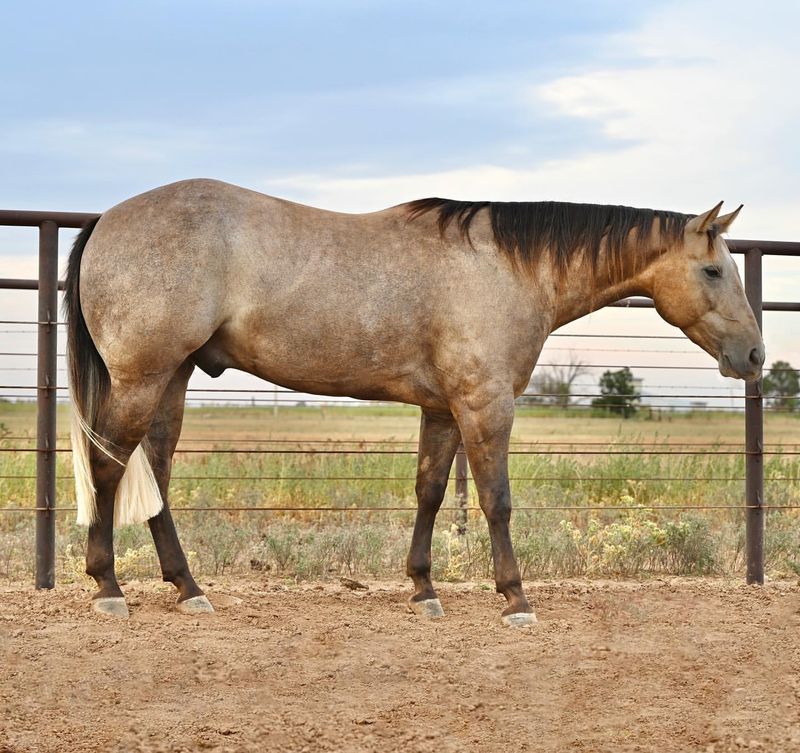
Champagne horses boast a stunning golden coat that shimmers under the sunlight, creating an appearance akin to a sparkling glass of the finest bubbly. This rare color results from the champagne gene, which dilutes both black and red base coats, leading to a distinctive gold hue.
A standout feature of champagne horses is their eye color, which is often a captivating hazel or amber, adding to their unique allure. The skin often has a slightly mottled appearance, giving these horses an extra touch of character.
Though not common, champagne horses can be found in various breeds, including the Tennessee Walking Horse and the American Quarter Horse, also known for their incredible speed.
Their enchanting appearance and unique coloration make them a favorite among breeders looking for something extraordinary.
6. Dapple Grey
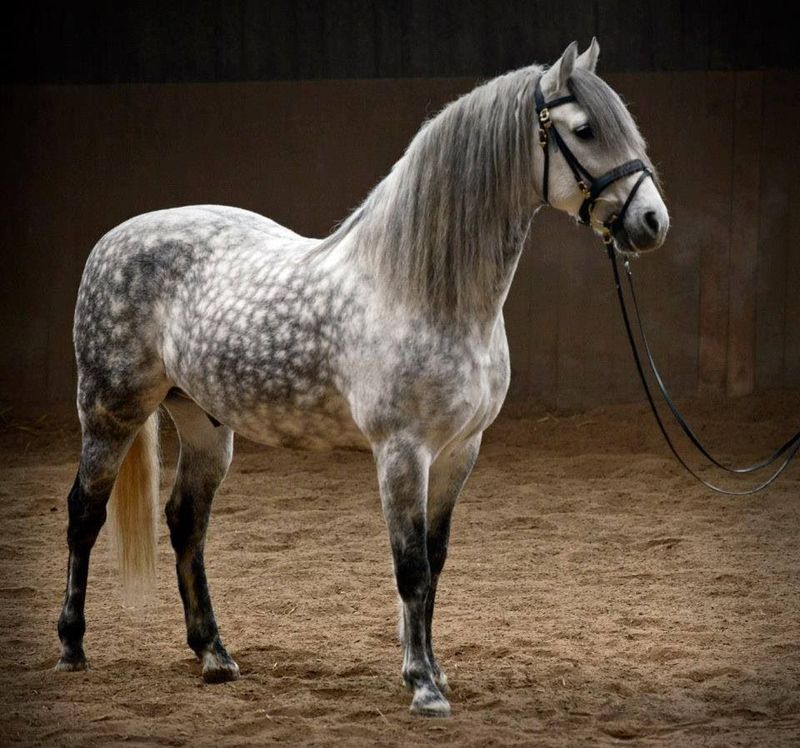
Dapple Grey horses are celebrated for their stunning and ever-changing appearance. Born dark, they gradually lighten with age, developing characteristic white or grey spots known as dapples. This transformation is mesmerizing, as each horse’s pattern is uniquely its own.
The dapples, often appearing on the flank and rump, create a beautiful contrast with the underlying grey coat, making these horses stand out in any setting. Their beauty is often highlighted in the show ring, where they are a favorite among judges and spectators alike.
Dapple Grey horses can be found in various breeds, with the pattern being especially common in breeds like the Andalusian and the Lipizzaner. Their elegance and graceful presence make them a cherished choice for riders and trainers seeking a horse with a timeless and classic appearance.
7. Grullo
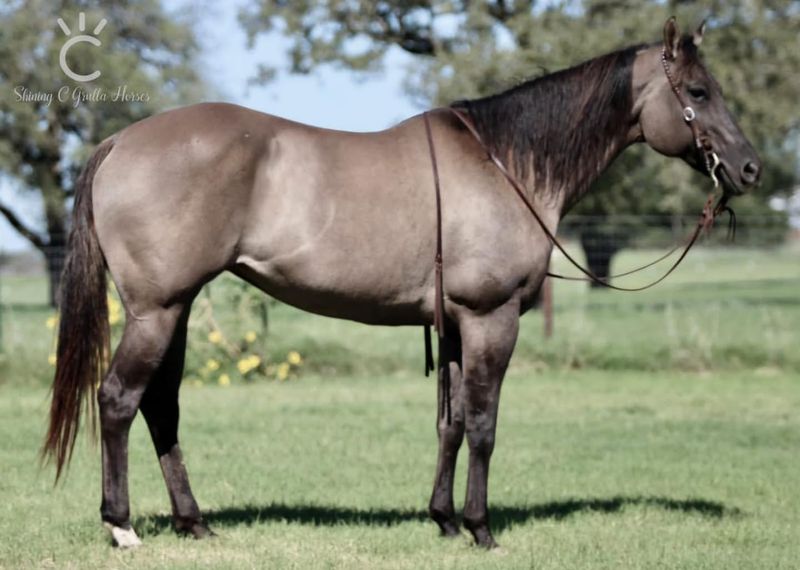
Grullo, also known as blue dun, is a distinctive color characterized by a smoky grey or mouse-colored coat, highlighted by black mane and tail. This unique color results from the dun gene acting on a black base coat, creating a striking and muted appearance.
Grullo horses often have primitive markings, such as a dorsal stripe running down their back and leg barring, adding to their unique look. These markings, combined with the subtle color, give them an almost wild and untamed appearance that many find appealing.
Though not overly common, grullo horses can be found in breeds like the American Quarter Horse and the Highland Pony. Their understated elegance and unique coloration make them a favorite among those who appreciate a horse with a distinctive and natural look.
8. Buckskin
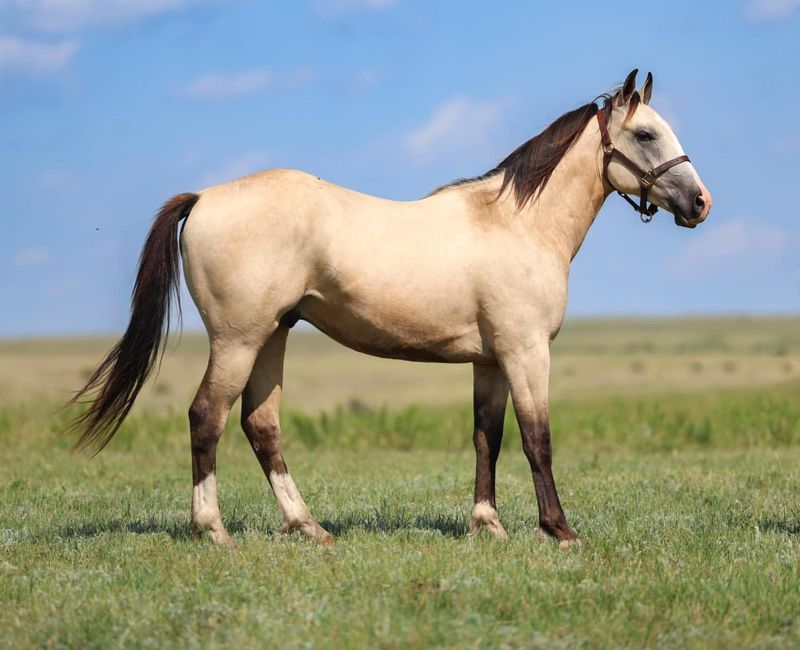
Buckskin horses are admired for their beautiful golden-yellow coats, which are strikingly accented by black mane, tail, and lower legs, known as ‘black points’. This color comes from the cream gene acting on a bay base coat, creating a striking contrast.
The buckskin’s appearance is reminiscent of a classic western movie horse, embodying strength and grace. Their color can vary slightly, with some individuals leaning more towards a lighter or darker shade, yet always maintaining the characteristic black points.
Buckskins are popular in many breeds, including the Quarter Horse and the Mustang, where they are celebrated for their striking looks and robust nature. Their unique coloration and iconic appearance make them a favorite among riders looking for a horse with both beauty and a bit of cinematic charm.
9. Palomino
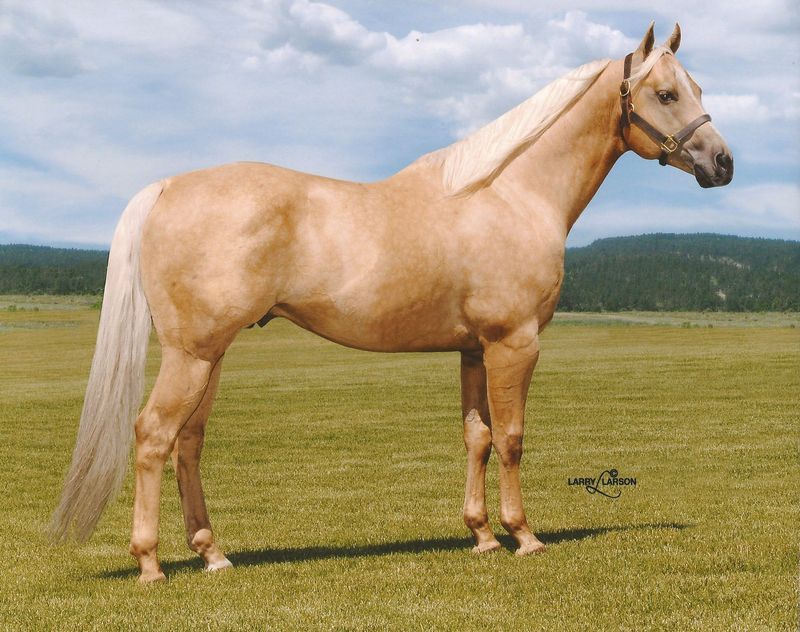
Palomino horses are easily identified by their luscious golden coats paired with a stark white or cream mane and tail. This beautiful color combination results from the cream gene acting on a chestnut base coat, creating a stunning visual impact.
The palomino’s striking appearance has made it a favorite in the show ring and among horse enthusiasts worldwide. Their coats can vary in shade, ranging from light cream to a rich gold, each presenting a unique and captivating look.
Commonly found in breeds like the American Saddlebred and the Quarter Horse, palominos are cherished for their vibrant coloration and spirited presence. Their enchanting look and graceful demeanor make them a popular choice for equestrians seeking a horse with undeniable charm and beauty.
10. Roan
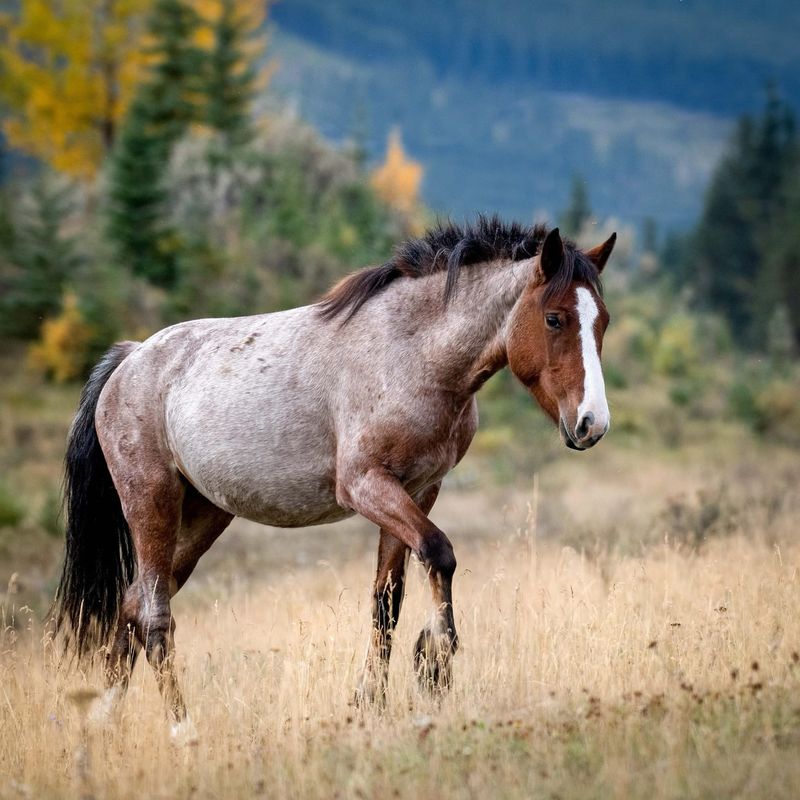
Roan horses present a fascinating blend of white and colored hairs, creating a unique speckled appearance that can vary significantly among individuals. This pattern can occur over any base color, but classic roans are often seen with bay, chestnut, or black coats.
The roan pattern does not change throughout the horse’s life, remaining consistent regardless of age or season, which adds to its allure. These horses can have striking contrasts, with the white hairs interspersed evenly, creating a shimmering effect that catches the eye.
Roan horses are found in various breeds, such as the Appaloosa and the Belgian Draft, where they are valued for their unique appearance and genetic diversity.
11. Bay
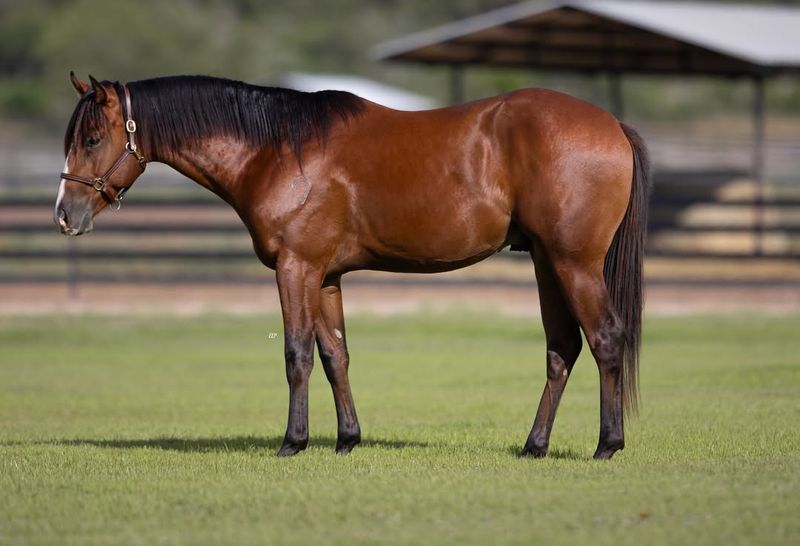
Bay horses are among the most recognizable and common horse colors, featuring a rich brown coat complemented by black mane, tail, and lower legs, known as ‘black points’. This classic color combination is both elegant and versatile, making it a beloved choice in the equestrian world.
The bay color can vary from a light, reddish-brown to a deep mahogany, each shade offering its own appeal. This versatility allows bay horses to be found in virtually every breed, showcasing their timeless and classic beauty.
Bay horses are celebrated for their striking appearance and sturdy nature, making them a popular choice for riders and breeders alike. Their reliable and consistent coloration, coupled with their widespread availability, ensures their continued popularity and presence in the horse community.
12. Chestnut
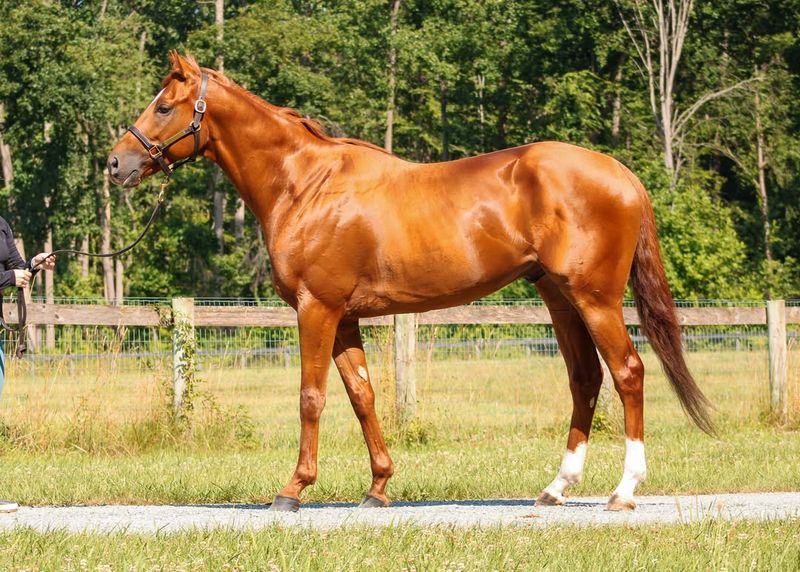
Chestnut horses are distinguished by their rich reddish-brown coats, which come in a variety of shades from light golden to dark liver chestnut. This versatile color is produced by the recessive chestnut gene, giving rise to one of the most widespread and beloved horse colors.
Lacking the black points seen in bays, chestnuts showcase a uniform color throughout their bodies, often highlighted by a mane and tail that may be lighter or match the coat color. This consistency of color adds to their appeal and makes them a favorite in many horseback riding disciplines.
Found in nearly every breed, chestnuts are known for their striking appearance and spirited nature. Their widespread presence and appealing coloration make them a perennial favorite among riders and breeders seeking a horse with both beauty and character.
13. Black
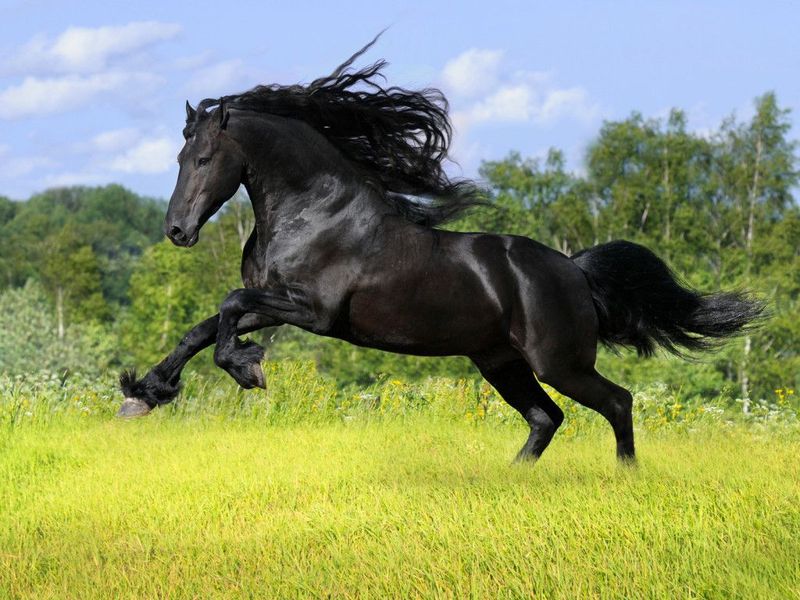
Black horses exude mystery and elegance, with their glossy, jet-black coats that seem to absorb the light around them. This classic and striking color is achieved when a horse has a uniform distribution of black pigment throughout its coat.
The beauty of a black horse is often highlighted by its simplicity, with no other colors to distract from its striking appearance. This uniformity can vary slightly, but true black horses remain a solid color without fading or lightening in the sun.
Black color is common for many breeds, including the Friesian, one of the largest horse breeds, celebrated for its timeless elegance. Their striking appearance and the aura of mystique they carry make them a favorite among those seeking a horse with both beauty and depth.
14. Bay Roan
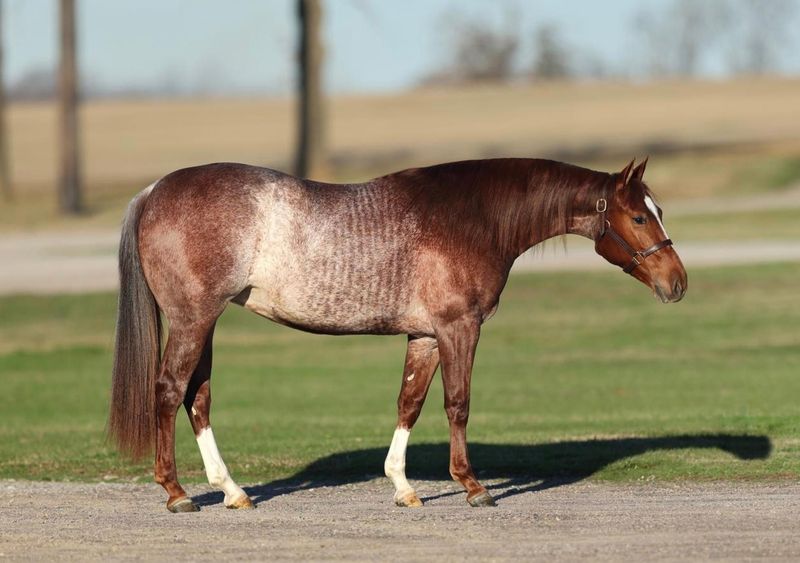
Bay Roan horses exhibit a fascinating blend of bay and white hairs, creating a unique speckled appearance that stands out in any setting. This pattern combines the classic bay color with the roan gene, resulting in a captivating and consistent look.
The bay roan coloration offers a rich tapestry of colors, with the white hairs often concentrated on the body, leaving the head and legs darker. This striking contrast is visually appealing and highlights the horse’s muscular build.
Bay Roans can be found in various breeds, such as the American Quarter Horse and the Welsh Pony, where they are admired for their unique appearance and genetic diversity. Their eye-catching pattern and consistent coloration make them a favorite among many horse lovers.
15. Seal Brown
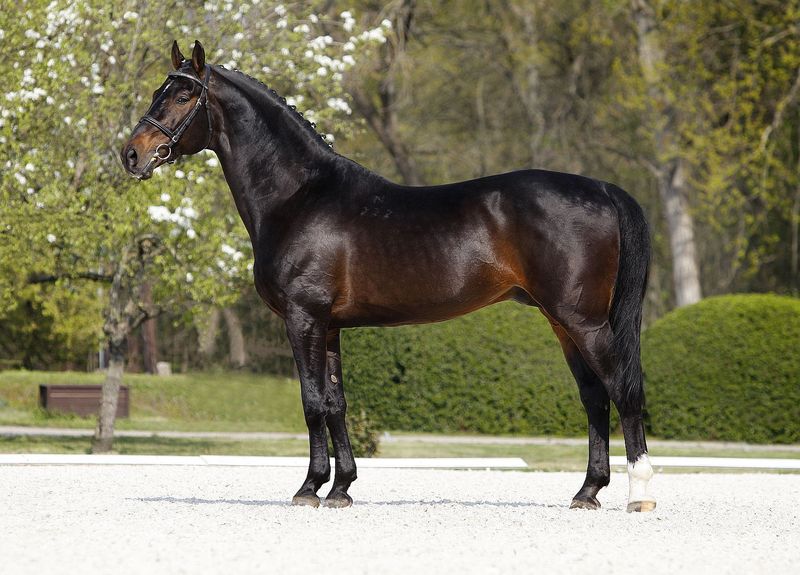
Seal Brown horses are noted for their dark brown coats, often accompanied by nearly black points, giving them a rich and earthy appearance. This color is sometimes confused with bay or black, but it has its distinct charm and allure.
The seal brown color can range from a dark chocolate to a nearly black shade, with lighter areas around the muzzle, flanks, and underbelly. This subtle variation in shade adds depth to the coat and enhances the horse’s overall appearance.
Seal Brown horses can be found in many breeds, including the Thoroughbred and the Morgan, where they are appreciated for their distinctive color and strong, robust build. Their unique appearance and captivating shade make them a favored choice among those looking for a horse with both character and beauty.
16. Piebald
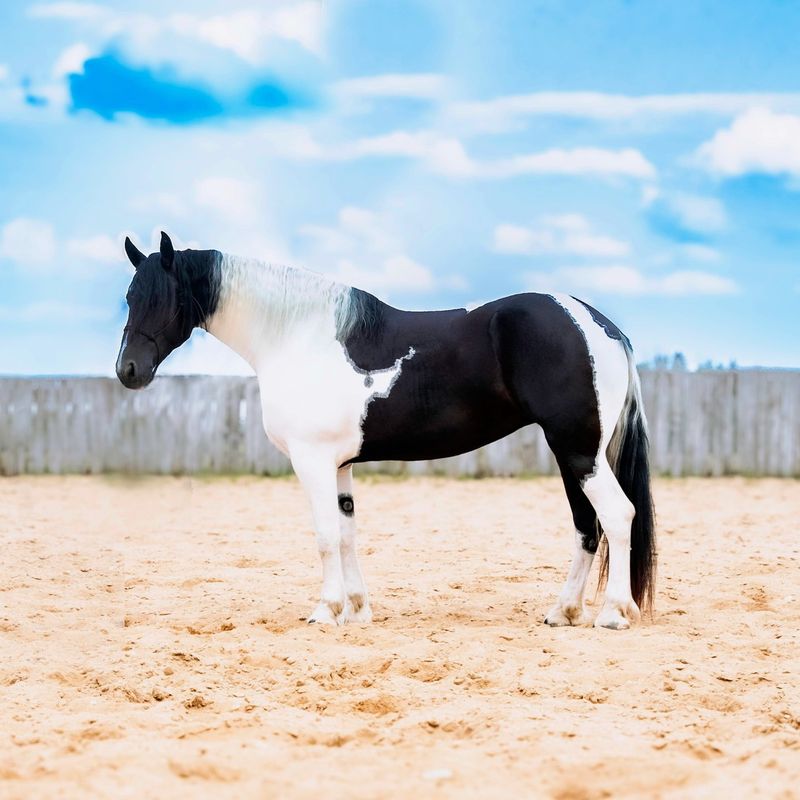
Piebald horses are easily recognized by their striking black and white patched coats, creating a bold and eye-catching appearance. This pattern is a result of the pinto gene, which creates large, irregular patches across the body.
The contrast between the black and white areas adds to the piebald’s visual appeal, making these horses stand out in any setting. This pattern is not only beautiful but also adds a sense of individuality to each horse, as no two piebalds are exactly alike.
Piebalds are commonly found in breeds like the Gypsy Vanner and the Irish Cob, where they are celebrated for their unique appearance and lively personalities. Their striking coloration and charming presence make them a favorite among those seeking a horse with both beauty and charisma.
17. Skewbald
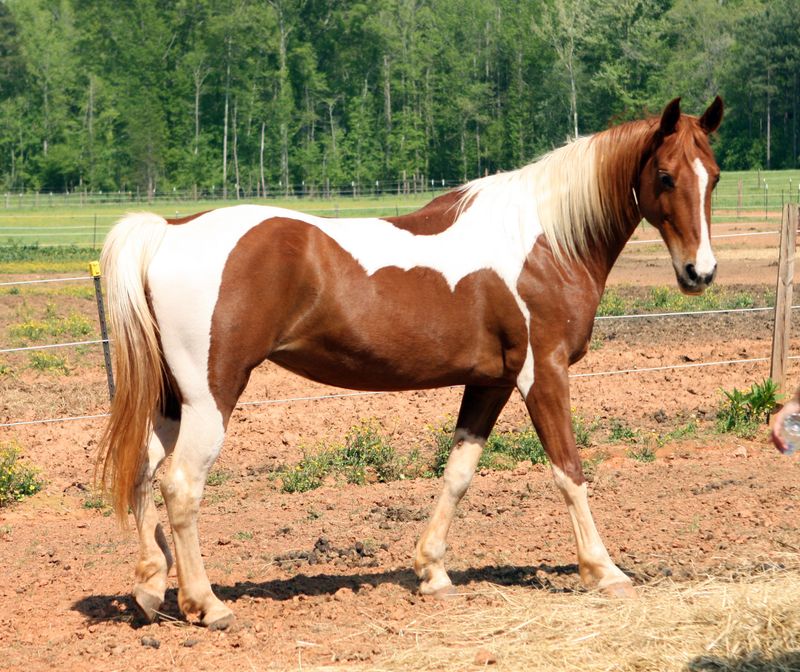
Skewbald horses are characterized by their beautiful brown and white patched coats, creating a warm and inviting appearance. This pattern, similar to piebald, is created by the presence of the pinto gene, but with brown or chestnut replacing the black areas.
The skewbald pattern is both eye-catching and unique, offering a visual delight for horse enthusiasts. Each skewbald has its own distinct pattern of patches, ensuring that no two are exactly the same, adding a personalized touch to their appearance.
These horses can be found in various breeds, such as the Gypsy Vanner and the Paint Horse, where they are appreciated for their striking looks and spirited nature. Their vibrant coloration and friendly demeanor make them a popular choice for those seeking a horse with both beauty and personality.
18. Grey
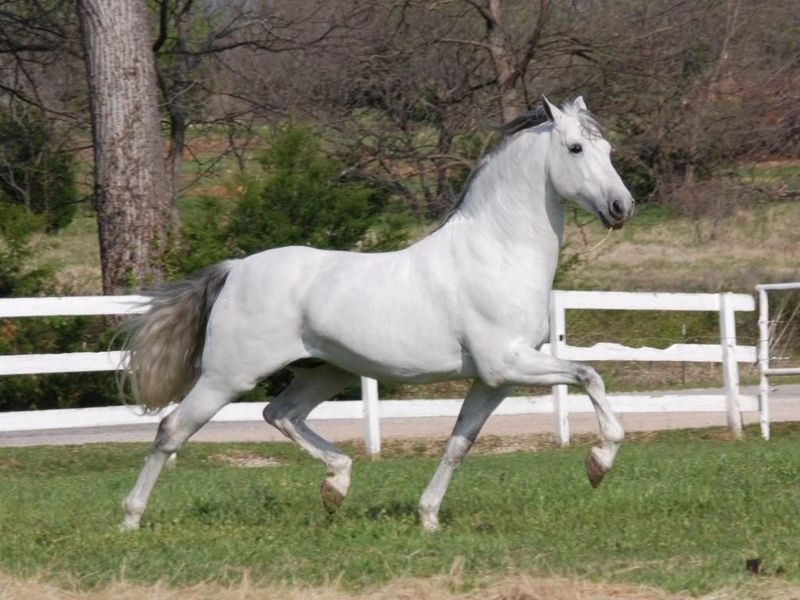
Grey horses are known for their unique ability to change color over time. Born with a solid color, they gradually become lighter as they age, eventually transitioning to a light or nearly white shade.
This transformation is part of the charm of grey horses, as each one develops its own unique pattern and shade over the years. Their coats can exhibit various dappling effects, creating a visually appealing and ever-changing appearance.
This color is common for breeds such as the Andalusian and the Lipizzaner. Their graceful transformation and captivating presence make them a favorite among those who appreciate a horse with both character and charm.
19. Sorrel
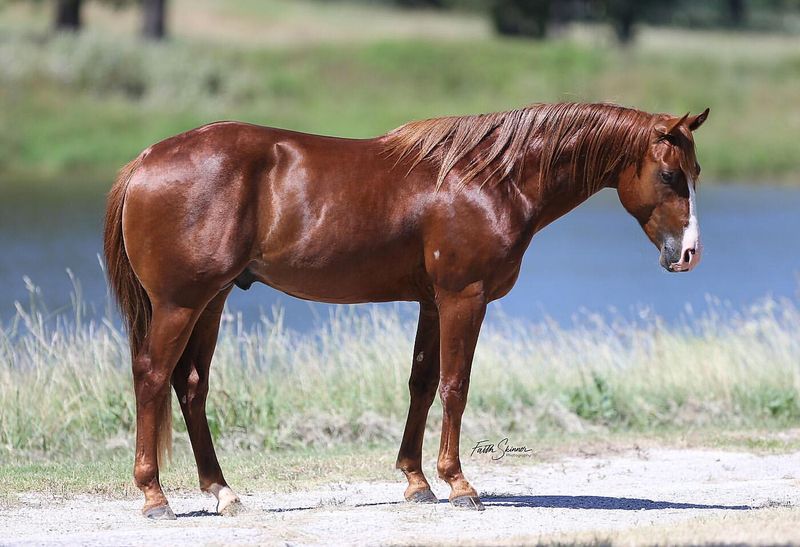
Sorrel horses are known for their bright reddish-brown coats, which are distinct from the deeper shades of chestnut. This lively color is often complemented by a flaxen mane and tail, adding to the horse’s overall appeal and charm.
The sorrel’s vibrant coloration makes it a popular choice among horse enthusiasts who appreciate a lively and spirited appearance. This color can vary slightly in shade, but always retains its characteristic brightness and warmth.
Commonly found in breeds like the American Quarter Horse and the Belgian Draft, sorrels are cherished for their striking looks and energetic demeanor. Their bright coloration and spirited nature make them a favorite among those seeking a horse with both beauty and vitality.

